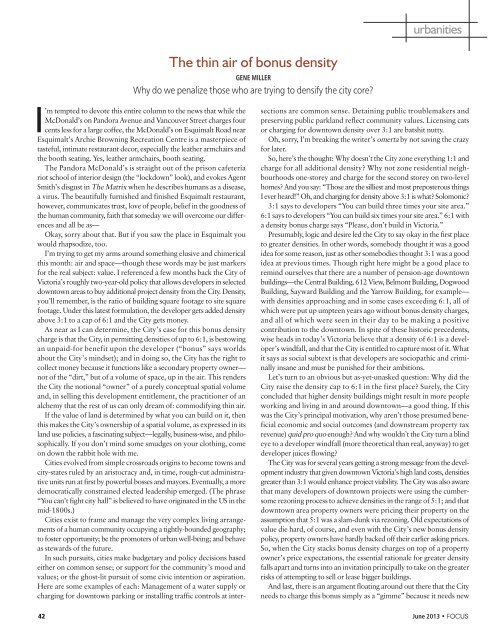***Mar 2006 Focus pg 1-32 - Focus Magazine
***Mar 2006 Focus pg 1-32 - Focus Magazine
***Mar 2006 Focus pg 1-32 - Focus Magazine
You also want an ePaper? Increase the reach of your titles
YUMPU automatically turns print PDFs into web optimized ePapers that Google loves.
urbanitiesThe thin air of bonus densityGENE MILLERWhy do we penalize those who are trying to densify the city core?I’m tempted to devote this entire column to the news that while theMcDonald’s on Pandora Avenue and Vancouver Street charges fourcents less for a large coffee, the McDonald’s on Esquimalt Road nearEsquimalt’s Archie Browning Recreation Centre is a masterpiece oftasteful, intimate restaurant decor, especially the leather armchairs andthe booth seating. Yes, leather armchairs, booth seating.The Pandora McDonald’s is straight out of the prison cafeteriariot school of interior design (the “lockdown” look), and evokes AgentSmith’s disgust in The Matrix when he describes humans as a disease,a virus. The beautifully furnished and finished Esquimalt restaurant,however, communicates trust, love of people, belief in the goodness ofthe human community, faith that someday we will overcome our differencesand all be as—Okay, sorry about that. But if you saw the place in Esquimalt youwould rhapsodize, too.I’m trying to get my arms around something elusive and chimericalthis month: air and space—though these words may be just markersfor the real subject: value. I referenced a few months back the City ofVictoria’s roughly two-year-old policy that allows developers in selecteddowntown areas to buy additional project density from the City. Density,you’ll remember, is the ratio of building square footage to site squarefootage. Under this latest formulation, the developer gets added densityabove 3:1 to a cap of 6:1 and the City gets money.As near as I can determine, the City’s case for this bonus densitycharge is that the City, in permitting densities of up to 6:1, is bestowingan unpaid-for benefit upon the developer (“bonus” says worldsabout the City’s mindset); and in doing so, the City has the right tocollect money because it functions like a secondary property owner—not of the “dirt,” but of a volume of space, up in the air. This rendersthe City the notional “owner” of a purely conceptual spatial volumeand, in selling this development entitlement, the practitioner of analchemy that the rest of us can only dream of: commodifying thin air.If the value of land is determined by what you can build on it, thenthis makes the City’s ownership of a spatial volume, as expressed in itsland use policies, a fascinating subject—legally, business-wise, and philosophically.If you don’t mind some smudges on your clothing, comeon down the rabbit hole with me.Cities evolved from simple crossroads origins to become towns andcity-states ruled by an aristocracy and, in time, rough-cut administrativeunits run at first by powerful bosses and mayors. Eventually, a moredemocratically constrained elected leadership emerged. (The phrase“You can’t fight city hall” is believed to have originated in the US in themid-1800s.)Cities exist to frame and manage the very complex living arrangementsof a human community occupying a tightly-bounded geography;to foster opportunity; be the promoters of urban well-being; and behaveas stewards of the future.In such pursuits, cities make budgetary and policy decisions basedeither on common sense; or support for the community’s mood andvalues; or the ghost-lit pursuit of some civic intention or aspiration.Here are some examples of each: Management of a water supply orcharging for downtown parking or installing traffic controls at inter-sections are common sense. Detaining public troublemakers andpreserving public parkland reflect community values. Licensing catsor charging for downtown density over 3:1 are batshit nutty.Oh, sorry, I’m breaking the writer’s omerta by not saving the crazyfor later.So, here’s the thought: Why doesn’t the City zone everything 1:1 andcharge for all additional density? Why not zone residential neighbourhoodsone-storey and charge for the second storey on two-levelhomes? And you say: “Those are the silliest and most preposterous thingsI ever heard!” Oh, and charging for density above 3:1 is what? Solomonic?3:1 says to developers “You can build three times your site area.”6:1 says to developers “You can build six times your site area.” 6:1 witha density bonus charge says “Please, don’t build in Victoria.”Presumably, logic and desire led the City to say okay in the first placeto greater densities. In other words, somebody thought it was a goodidea for some reason, just as other somebodies thought 3:1 was a goodidea at previous times. Though right here might be a good place toremind ourselves that there are a number of pension-age downtownbuildings—the Central Building, 612 View, Belmont Building, DogwoodBuilding, Sayward Building and the Yarrow Building, for example—with densities approaching and in some cases exceeding 6:1, all ofwhich were put up umpteen years ago without bonus density charges,and all of which were seen in their day to be making a positivecontribution to the downtown. In spite of these historic precedents,wise heads in today’s Victoria believe that a density of 6:1 is a developer’swindfall, and that the City is entitled to capture most of it. Whatit says as social subtext is that developers are sociopathic and criminallyinsane and must be punished for their ambitions.Let’s turn to an obvious but as-yet-unasked question: Why did theCity raise the density cap to 6:1 in the first place? Surely, the Cityconcluded that higher density buildings might result in more peopleworking and living in and around downtown—a good thing. If thiswas the City’s principal motivation, why aren’t those presumed beneficialeconomic and social outcomes (and downstream property taxrevenue) quid pro quo enough? And why wouldn’t the City turn a blindeye to a developer windfall (more theoretical than real, anyway) to getdeveloper juices flowing?The City was for several years getting a strong message from the developmentindustry that given downtown Victoria’s high land costs, densitiesgreater than 3:1 would enhance project viability. The City was also awarethat many developers of downtown projects were using the cumbersomerezoning process to achieve densities in the range of 5:1; and thatdowntown area property owners were pricing their property on theassumption that 5:1 was a slam-dunk via rezoning. Old expectations ofvalue die hard, of course, and even with the City’s new bonus densitypolicy, property owners have hardly backed off their earlier asking prices.So, when the City stacks bonus density charges on top of a propertyowner’s price expectations, the essential rationale for greater densityfalls apart and turns into an invitation principally to take on the greaterrisks of attempting to sell or lease bigger buildings.And last, there is an argument floating around out there that the Cityneeds to charge this bonus simply as a “gimme” because it needs new42 June 2013 • FOCUS
















